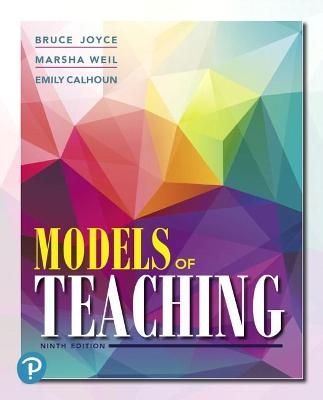
Models of Teaching
Pearson (Verlag)
978-0-13-489258-0 (ISBN)
Bruce Joyce grew up in New Jersey, was educated at Brown University and, after military service, taught in the schools of Delaware. He was a professor at the University of Delaware, the University of Chicago, and Teachers College, Columbia University. In all those settings, he directed the teacher education programs and, at Teachers College, the Agnes Russell School – the laboratory school of the college. His scholarship and practice have centered on teaching, teacher education, professional development, and school improvement. He has been a visiting scholar at the University of Hong Kong, the University of Toronto, the Western Australia Institute of Technology; and he has been an all-India Fulbright Scholar and a USAID general technical assistant to Egypt's Ministry of Education. His technical services to American, Asian, and European schools are focused on models of teaching, professional development, and school improvement. Emily Calhoun has a B.A. in English from Georgia College in Milledgeville, and M.Ed. in early childhood education and reading from Georgia Southwestern College in Americus, and an Ed.D. from the University of Georgia in Athens. Emily has taught at the elementary, secondary, and university levels. She has worked as a consultant with intermediate service agencies, as a coordinator of the Georgia League of Professional Schools at the University of Georgia, and as a K-12 Language Arts coordinator within a school district. Since 1991, she has been director of The Phoenix Alliance in Saint Simons Island. In that position, she has partnered with districts, states, and provinces in extensive professional development and school improvement projects. These have generated considerable positive effects for teachers, administrators, and students and have included research on school improvement, especially on action research, and the teaching of reading and writing. Her international work includes professional development and/or visiting scholar positions in Canada, the United Kingdom, Finland, Columbia, Thailand, and Hong Kong.
Preface
A Note on Heritage
Acknowledgments
Part One - Models of Teaching: A Working Professional Repertoire
1. Where Models of Teaching Come From
2. Building the Community of Expert Learners: Taking Advantage of Our Students’ Capacity to Learn (and Ours)
Part Two - The Basic Information-Processing Models of Teaching
3. Learning to Learn Inductively: The Really, Really Basic Model of Teaching
4. Scientific Inquiry: Learning through Investigations
5. The Picture Word Inductive Model: Developing Literacy Through Inquiry
Part Three - Special Purpose Information-Processing Models
6. Concept Attainment : The Explicit Teaching of Important Concepts
7. Synectics: Teaching the Left Brain to Put the Right Side to Work
8.. Memorization: Getting the Facts Straight, Now and for the Long Term
9. Using Advance Organizers to Design Presentations: Scaffolding Lectures, ICT, and Distance Offerings
10. The Inquiry Training Model: Training Inquiry Skills Directly
Part Four - The Social Family of Models of Teaching
11. Partners in Learning: Getting Everybody on Board
12. Group Investigation: Rigorous Inquiry through Democratic Process
13. Role Playing: Studying Values
Part Five - The Personal Family of Models
14. Nondirective Teaching - The Learner at the Center
15. Developing Positive Self-Concepts
Part Six - The Behavioral Family of Models
16. Explicit Instruction: Comprehension When Reading and Composing When Writing
17. Mastery Learning: Bit by Bit, Block by Block, We Climb Our Way to Mastery
18. Direct Instruction: Applied Psychology Goes to Work
Part Seven - The Conditions of Learning, Learning Styles, and Conceptual Levels.
19. Creating Curricula: The Conditions of Learning
20. Expanding Our Horizons: Making Discomfort Productive
Appendix: Peer Coaching Guides
| Erscheinungsdatum | 04.01.2018 |
|---|---|
| Sprache | englisch |
| Maße | 100 x 100 mm |
| Gewicht | 100 g |
| Themenwelt | Sozialwissenschaften ► Pädagogik ► Berufspädagogik |
| ISBN-10 | 0-13-489258-5 / 0134892585 |
| ISBN-13 | 978-0-13-489258-0 / 9780134892580 |
| Zustand | Neuware |
| Haben Sie eine Frage zum Produkt? |
aus dem Bereich


